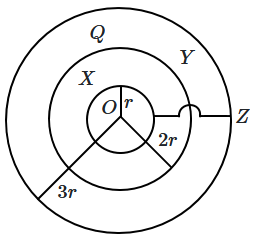A lead bullet penetrates into a solid and melts. Assuming that \(50\%\) of its kinetic energy was used to heat it, the initial speed of the bullet is: (the initial temperature of the bullet is \(25^\circ\mathrm{C}
\) and its melting point is \(300^\circ\mathrm{C}
\)). Latent heat of fusion of lead \(=2.5\times10^4~\mathrm{J/Kg}\) and specific heat capacity of lead \(=125~\mathrm{J/Kg-K}\).
1. \(
100 \mathrm{~m} / \mathrm{s}
\)
2. \( 490 \mathrm{~m} / \mathrm{s}
\)
3. \( 520 \mathrm{~m} / \mathrm{s}
\)
4. \( 360 \mathrm{~m} / \mathrm{s}\)
A lead bullet penetrates into a solid and melts. Assuming that \(50\%\) of its kinetic energy was used to heat it, the initial speed of the bullet is: (the initial temperature of the bullet is \(25^\circ\mathrm{C}
\) and its melting point is \(300^\circ\mathrm{C}
\)). Latent heat of fusion of lead \(=2.5\times10^4~\mathrm{J/Kg}\) and specific heat capacity of lead \(=125~\mathrm{J/Kg-K}\).
1. \(
100 \mathrm{~m} / \mathrm{s}
\)
2. \( 490 \mathrm{~m} / \mathrm{s}
\)
3. \( 520 \mathrm{~m} / \mathrm{s}
\)
4. \( 360 \mathrm{~m} / \mathrm{s}\)

1. \( 1 / 2 \)
2. \( 1 / 3 \)
3. \( 4 / 3 \)
4. \( 2 / 3\)

| (i) | Ratio of work functions \(\phi_1,\phi_2\) and \(\phi_3\) = 1: 2: 4 |
| (ii) | Ratio of work functions \(\phi_1,\phi_2\) and \(\phi_3\) = 4: 2:1 |
| (iii) | \(\tan\theta\propto\frac{hc}{e},\) Where h = plank’s constant, c = speed of light |
| (iv) | The violet-colour light can eject photoelectrons from metals 2 and 3 |
2. (i), (iv)
3. (ii), (iii)
4. (i), (ii) and (iv)
The concentric, conducting spherical shells \(X,~ Y\) and \(Z\) with radii \(r, ~2r\) and \(3r\) respectively. \(X\) and \(Z\) are connected by a conducting wire and \(Y\) is uniformly charged to charge \(Q\) as shown in the figure. Charges on shells \(X\) and \(Z\) will be:
1. \(qx=\frac{Q}{4},qz=\frac{-Q}{6}\)
2. \(qx=\frac{-Q}{4},qz=\frac{Q}{4}\)
3. \(qx=\frac{Q}{4},qz=\frac{-Q}{4}\)
4. \(qx=\frac{-Q}{6},qz=\frac{Q}{4}\)
A particle slides down on a smooth incline of inclination , fixed in an elevator going up with an acceleration of 2 m/s2. The box of incline has a length of 4 m. The time taken by the particle to reach the bottom will be:
1. \(\frac89\sqrt3s\)
2. \(\frac98\sqrt3s\)
3. \(\frac43\sqrt{\frac{\sqrt3}{2}}s\)
4. \(\frac34\sqrt{\frac{\sqrt3}{2}}s\)
A stone projected with a velocity \(u\) at an angle \(\Big(\frac{\pi}{2}-\theta\Big)\) with the horizontal reaches maximum height \(H_1\) When it is projected with velocity \(u\) at an angle with the horizontal, it reaches maximum height Hz. The relation between the horizontal range \(R\) of the projectile, \(H_1\) and \(H_2\) is:
1. \(R=4\sqrt{H_1H_2}\)
2. \(R=4({H_1-H_2})\)
3. \(R=4({H_1+H_2})\)
4. \(R=\frac{H^2_1}{H_2^2}\)
Two batteries of emf \(3~\text V\) and \(6~\text V\) with internal resistances \(2~\Omega\) and \(4~\Omega\) are connected in a circuit with a resistance of \(10~\Omega\) as shown in the figure. The current and potential difference between the points \(P\) and \(Q\) are:
1. \(\frac{3}{16}A~\text{and}~\frac{8}{15}V\)
2. \(\frac{16}{3}A~\text{and}~\frac{15}{8}V\)
3. \(\frac{3}{16}A~\text{and}~8~V\)
4. \(\frac{3}{16}A~\text{and}~\frac{15}{8}V\)
A light string passes over a frictionless pulley. To one of its ends, a mass of 8 kg is attached. To its other end, two masses of 7 kg each are attached. The acceleration of the system will be:

2. 5.10 g
3. 20.36 g
4. 0.27 g
A capillary tube of length \(L\) and radius \(v\) is connected with another capillary tube of the same length but half the radius in series. The rate of the steady volume flow of water through the first capillary tube under a pressure difference of \(p\) is \(V.\) The rate of the steady volume flow through the combination will be: (the pressure difference across the combination is \(p\))
1. \(17~V\)
2. \(\frac{16}{17}~V\)
3. \(\frac{V}{17}\)
4. \(\frac{17}{16}~V\)





